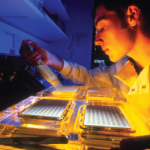SAN FRANCISCO—By harnessing the power of next generation sequencing strategies and combining them with clever statistical strategies and tools, investigators are striving to define causal pathways of and mechanisms underlying complex diseases, such as rheumatoid arthritis, according to Soumya Raychaudhuri, MD, PhD, associate professor, Harvard Medical School, Brigham and Women’s Hospital, Boston, during a session on Next Generation Sequencing: A Novel Tool for Genomic Discovery at the 2015 ACR/ARHP Annual Meeting.

Dr. Raychaudhuri
In the session, Dr. Raychaudhuri was one of three panelists to speak on current investigative activity into the use of next generation sequencing to understand complex diseases. Such sequencing is used to target the discovery of rare variants in the genome to better understand complex trait diseases, such as rheumatoid arthritis (RA). More recently applied genome-wide association studies (GWAS) query common variants; with this strategy, causal alleles and mutations are difficult to ascertain, due to the many linkages among these variants, which doesn’t permit isolating one variant from the other to truly know what is causal or not. In contrast, rare variants more readily lead to understanding causation given that these rare variants often are not linked to nearby variants.
“Common variants have been around for a long time and have risen to a common frequency, and whatever functional potential they may be conferring has been whittled away by evolution,” said Dr. Raychaudhuri, saying that rare variants are more recently derived and, therefore, have not been purified by forces of negative selection.
“If rare variants can be identified, ascribing function can often be more clear,” he said.
The panel described current work underway using next generation sequencing strategies to identify rare variants associated with inflammatory diseases.
Mapping Rare Variants
To illustrate the power and principles of rare variant discovery, Dr. Raychaudhuri described research he and his colleague, Johanna Seddon, MD, professor of ophthalmology, Tufts Medical Center, Boston, and other collaborators have undertaken using next generation sequencing in which they successfully identified a rare haplotype associated with age-related macular degeneration (AMD). This rare haplotype was discovered by first phasing together known common variants of AMD and using the phased genotype data to identify rare and high risk haplotypes. Further study showed an association between people who had this rare haplotype and a risk of developing AMD, an association thought unlikely to be from chance alone.
To see if they could identify a rare, more clearly functional variant that might explain the risk associated with this rare haplotype, the investigators used next generation sequencing to sequence the entire gene encoding complement factor H (CFH) region in 84 people representing all 11 haplotypes. They found that the association of the haplotype was explained by a single rare mutation (R1210C) in CFH that links the pathophysiology of AMD to aHUS. People with this mutation are at high risk of developing AMD.1

